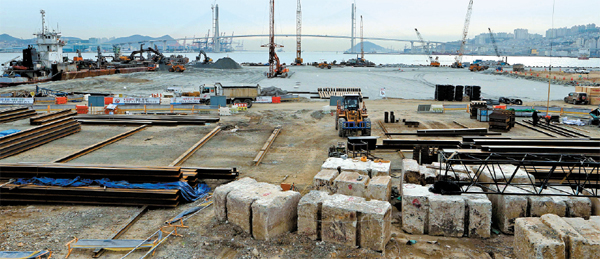Governments see projects go awry

North Port Bridge can be seen in the background behind the construction site at Busan North Port terminal on Dec. 16. By Song Bong-geun
Although Yeongdo District in Busan already has an international cruise terminal, it’s not equipped to handle a vessel of that size, which prompted North Port’s redevelopment.
The international terminal project, which is scheduled for completion in February 2015, cost a total of 306 billion won ($289 million). Together with the Busan Port Authority, Busan Metropolitan Government is slated to cover up to 253 billion won, while the central government will provide an additional 53 billion won.
However, despite the frenzied construction work and the massive investments, the project was poorly planned, and that means the terminal likely won’t be able to accommodate the supersized luxury cruise liners for which it was built.
Right now, it stands that all vessels must pass through North Port Bridge to get to harbor; however, the bridge - which is currently under construction - can only clear vessels 60 meters-high (196.9 feet) or less, and most new supersize cruise liners are often taller than that height allowance.
Carnival Corporation, for example, which recently opened a branch in Seoul, has its 148,000 ton Queen Mary 2, which stands 72 meters above sea level. And Royal Caribbean International’s Voyager of the Seas - currently sailing around Asia - is just over the limit at 63.5 meters high.
The North Port Bridge was also a headache from its inception.
When its construction began in 2007, the international cruise terminal was already planned, and it was becoming clear that more cruise ship companies were interested in building larger vessels. Yet the plan for the North Port Bridge was approved without changing its design to more accurately reflect the trend in the industry.
But North Port is just one example of multiple instances in which regional governments have wasted budget funds on defective or ill-planned initiatives. In the case of Busan, officials essentially poured 306 billion won into the construction of a new cruise ship terminal that won’t satisfy any of its intended objectives.
Over the past few years, other regional governments have also seen their plans go awry.
In 2009, the Incheon Metropolitan Government hosted the Global Fair and Festival, an international event centered on future cities. The city government initially called the event “World City Expo” and started planning. However, because Shanghai was scheduled to host the World Expo the following year, the International Expositions Bureau prohibited Incheon officials from using the word “expo” in their marketing.
The city ended up down-scaling and redesigning its event to comply, but its initial investment of 12.2 billion won for planning and promotion was wasted.
South Jeolla’s provincial government had similar setbacks.
It spent 6.7 billion won to replicate an excursion boat shaped like the Turtle Ship manned by Adm. Yi Sun-sin during the Joseon Dynasty (1392-1910), as well as a special port to accommodate it. The boat links the historical sites of Haenam and Jindo Island in South Jeolla and is capable of carrying 174 passengers.
Although the province offers four daily tours, the average number of passengers is usually less than 50 per day. Services were temporarily suspended in March and resumed in September, but visitors remained scarce, and there were only six operations over September and October.
Likewise, Hampyeong County in South Jeolla built an ecological park specializing in amphibians and reptiles with a price tag of 19.5 billion won; the county paid 6.3 billion, while the central government and South Jeolla Provincial Government picked up the rest.
The park, however, has yet to open because the county failed to come up with the yearly operation expense of 1.1 billion won. Designed to show off 600 animals across 90 species, it was scheduled to open in August 2011, but construction was only completed in July.
Over the past five months, in the time that the park has been closed, 41 animals have died, resulting in a 300 million won loss for the county.
“We thought the South Jeolla Provincial Government, which supported the construction fee, would pay for the operation costs,” said one county official.
South Jeolla said it has no plans to provide further funding; Hampyeong County government said it will come up with its own budget of 600 million won next year to open the park, but doubts about the facility’s future continue to worry officials.
“In order to prevent regional governments from wasting their budgets for projects mainly designed to glorify governors and mayors, residents should have strong oversight,” said Kang Jae-gyeu, a professor of law at Inje University.
“Under the current regulations, residents have the right to use a special system to oust local government officials,” Kang added. “The recall system can be exercised for legal violations and intentional negligence. [A politician’s] wasting of the budget should also be included in the system.”
But perhaps the most unique example of wasteful spending was seen on Jeju Island. The province received an international telephone bill of 16.3 billion won at the end of 2011. At the time, the province had made more than 100 million international telephone calls in an attempt to be selected as one of the world’s New7Wonders of Nature, an initiative hosted by a private Swiss organization that collected information through a global poll.
Whether Jeju’s efforts were effective remains unclear.
The number of foreign tourists who visited Jeju numbered around 1 million in 2011 when the survey was conducted. That figure more than doubled to 2.2 million as of Dec. 15. The increase, however, was likely an outcome of the Korean Wave’s spread over China. The number of tourists from China during that period rose by 1.2 million.
Jeju Provincial Government has so far paid off 11 billion won of its phone bill.
BY SPECIAL REPORTING TEAM [myoja@joongang.co.kr]










with the Korea JoongAng Daily
To write comments, please log in to one of the accounts.
Standards Board Policy (0/250자)